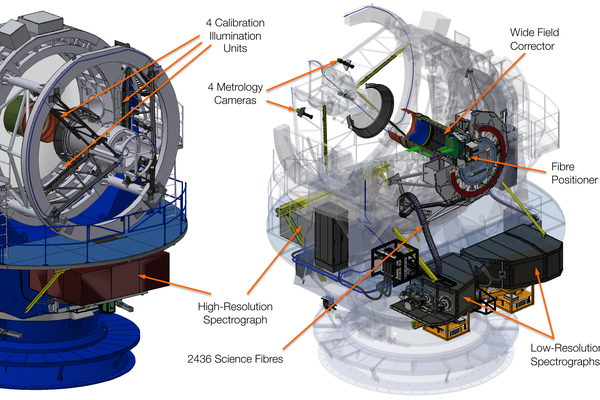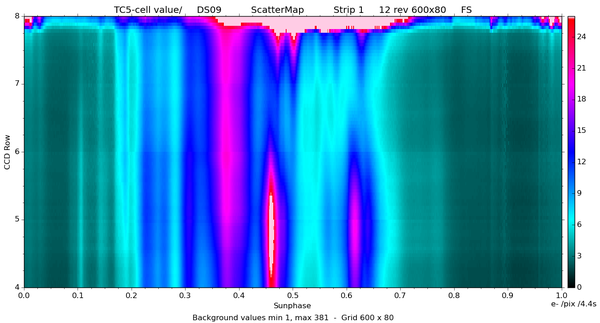Instrumentation and Software
4MOST

4MOST is a major new facility, currently under construction under AIP leadership to create a wide-field, high-multiplex spectroscopic survey facility for the VISTA telescope at the Paranal Observatory of the European Southern Observatory (ESO) . Starting in 2023 as the principle instrument on the VISTA telescope, 4MOST will deploy 2436 optical fibres in a 4.2 square degree field-of-view to one high-resolution and two medium-resolution spectrographs. It will collect high quality spectra over a period of at least 10 years yielding spectra of over 40 million stars and more than 40 million galaxies at resolution R>5000 and of 5 million stars at R~20,000.
The 4MOST science goals are mostly driven by four key all-hemisphere, space-based observatories of prime European interest: Gaia and PLATO (Galactic Archeology), eROSITA (High-Energy Sky), and Euclid (Cosmology and Galaxy Evolution). These main science cases drive the Key Surveys covering a large fraction of the Southern sky, with bright time mostly devoted to the Milky Way disk and bulge areas and the Magellanic Clouds, and the dark/gray time essentially devoted to extra-galactic targets. In addition there will be a significant of the fibre-hours devoted to ESO's Community Surveys, making 4MOST a true general-purpose survey facility, capable of delivering spectra of samples of objects that are spread over a large fraction of the sky. 4MOST can also follow-up tens of thousands of VRO/LSST, eROSITA and SKA transients per year.
The Milky Way and Local Volume and the Dwarf Galaxies and the Galactic Halo sections at AIP are developing several of the main Galactic Archeology science cases to study the Milky Way halo, disk and bulge/bar components and the Magellanic clouds, and perform extensive simulations to test the feasibility of the science with 4MOST. We are furthermore contributing to instrument science, by contributing to commissioning, calibration, and science performance verification activities, and to the development of the operations scheme and software of 4MOST.
Gaia

Two-dimensional map of the diffuse background light for Gaia RVS. Horizontal: time of one satellite rotation (6 h), Vertical: position on the 4 CCD detectors.
Credit: ESA / DPAC / AIP, Katja WeingrillESA's space mission Gaia measures the positions, distances, space motions and many physical characteristics of the stars in our Galaxy and beyond. In the Gaia Early Data Release 3, DPAC published positions and brightnesses for more than 1.8 billion sources. The Data Processing and Analysis Consortium (DPAC) is responsible for the processing of Gaia's data and our research section is involved in the DPAC since 2007.
Within the DPAC, the AIP is responsible for the background correction of the spectra. The Radial Velocity Spectrograph (RVS) onboard Gaia is an integral field spectrograph (IFU), meaning that neighbouring sources can create overlapping spectra on the detector. In case one of these spectra was not read out, the background correction becomes a non trivial task. The Milky Way and the Local Volume section at AIP is modelling the spectral light distribution of contaminating point source in a target readout window, using as much information as is available from the source. In the ideal case, this will include atmospheric parameters to choose a template spectrum, radial and rotational velocity for line shift and broadening, the magnitude for the brightness and the relative position for the spatial and spectral contribution.
Apart from the point source background spectra, there is also a diffuse background arising from zodiacal light, extended objects as nebulae or straylight. Other than the point source background, which is calculated from the stellar characteristics, the diffuse background contribution is measured. This is done in empty parts of the readout windows. After cleaning them from cosmic rays, ccd defect, saturated and disturbed pixels, blends and point sources contamination, the background level is measured and a two dimensional map of solar phase versus detector position is constructed. From this map, the level of diffuse background light can be estimated for each target object.
Furthermore, together with the Dwarf Galaxies and the Galactic Halo section we are developing a Gaia pipeline to identify new sources from two dimensional Sky Mapper images. These socalled Service Interface Function (SIF) images of the Sky Mapper have been recorded regularily since 2014 for the most crowded regions on the sky (Globular Clusters, the Milky Way and Magellanic Cloud centres), in which the nominal Gaia pipelines reach their limitations. The goal is to extract astrometry and photometry for these new sources in order to improve the completeness of the Gaia Catalogues in the nine selected regions of the sky. The AIP takes a main role in this new DPAC group, as the main software developer and the manager of the SIF CF team are located at AIP.
The AIP is an official Gaia Partner Data center and the AIP section Supercomputing and E-Science offers the complete Gaia Catalogue on gaia.aip.de.